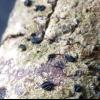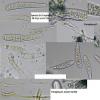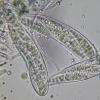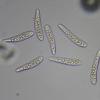
20-12-2025 23:08
Patrice TANCHAUDBonsoir, récolte sur sol sablonneux dans l'arri�

21-12-2025 09:32
Hello.A tiny ascomycete found embedded in wood in

20-12-2025 15:47
Mirek GrycHi.These grew on pine wood that was heavily covere

18-12-2025 21:17
Pol DebaenstThe identification took me to Byssonectria deformi

15-12-2025 07:09
 Danny Newman
Danny Newman
indet. Rutstroemiaceae sp. on unk. fallen leavesMc

19-12-2025 10:10
Patrice TANCHAUDBonjour, récolte réalisée en milieu dunaire, a

18-12-2025 17:23
 Bruno Coué
Bruno Coué
Bonjour,je serais heureux d'avoir votre avis sur c
Durella connivens ?
Carmel Sammut,
13-01-2016 21:53
Spores 6-9 septate, 30-50µm x 6.4-7.8µm
Asci 8 spored IKI -ve,
Paraphyses branched with a few simple ones
It looks like a Durella species and D. connivens seems to fit well
Hans-Otto Baral,
13-01-2016 21:59

Re : Durella connivens ?
... but it isn't :-)
It is Patellaria atrata. (or "crassispora" because the exudate looks more bluish than olive)
Zotto
It is Patellaria atrata. (or "crassispora" because the exudate looks more bluish than olive)
Zotto
Carmel Sammut,
13-01-2016 22:29
Re : Durella connivens ?
Thanks Zotto.
I did consider Patellaria atrata, but the mature spores did not have the large oil drops which seem to be typical to that species.
Re. 'crassispora' I am not aware of a species with that epithet in Patellaria.
I did consider Patellaria atrata, but the mature spores did not have the large oil drops which seem to be typical to that species.
Re. 'crassispora' I am not aware of a species with that epithet in Patellaria.
Hans-Otto Baral,
14-01-2016 09:34

Re : Durella connivens ?
Exactly, the multiguttulate spore content is typical of P. crassispora ined. But that species has wider spores than you indicate, about 8-10 µm.
Carmel Sammut,
14-01-2016 12:03
Re : Durella connivens ?
Thanks Zotto for the clarification.





